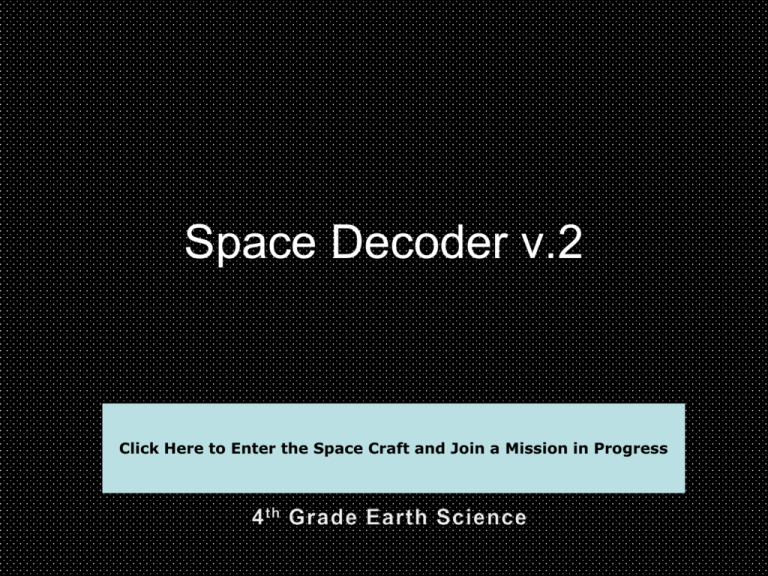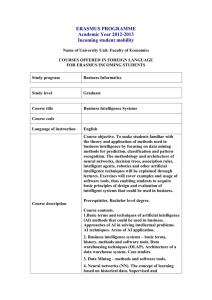
Space Decoder v.2
Click Here to Enter the Space Craft and Join a Mission in Progress
Status: Engaged
Active Targeting: On
Radar: Active
Location:W34.345 N24.234
Back
Trip Navigation Status: ON
On Board Computer:
Current Flying Speed: 23.4 Tagets
Next
INCOMING MESSAGE
FROM HIGH COMMAND
Back
Incoming Message from Central Intelligence Below:
On Board Computer:
Currently Calculating Incoming Message…
Next
INCOMING MESSAGE
FROM HIGH COMMAND
Back
Incoming Tip from Central Intelligence Below:
On Board Computer:
Currently Calculating Incoming Transmission
Next
Welcome Alliance Decoder
We are so grateful that you have agreed to help us.
As you have heard, aliens have stolen our space ships.
They are attempting to escape in them.
We have not been able to stop them because we cannot
identify them from the ships controlled by our forces.
We know that you can help us identify the ships, and allow us to recapture them.
On your display panel, you will see clues from our central intelligence agency.
Help us identify the ships by clicking on them.
I know with you on the job we will be safe.
Thank you, and good luck.
INCOMING MESSAGE
FROM HIGH COMMAND
When Ready – Click Next to Begin
Long Range Scanners Indicate - Aircraft Approaching
*Switching to Targeting Controls - Engaging Enemy*
Next
Status: Engaged
Active Targeting: On
Radar: Active
Location:W34.345 N24.234
Incoming Tip
from Central
Intelligence Below:
WE KNOW YOU CAN DO IT, PLEASE CONCENTRATE AND TRY IT AGAIN.
WE ARE SENDING YOU BACK IN.
CLICK THE TRY AGAIN BUTTON TO CONTINUE.
Try
Again
Status: Engaged
Active Targeting: On
Radar: Active
Location:W34.345 N24.234
Incoming Tip
from Central
Intelligence Below:
Man-made satellites move around Earth much like
A. planets
B. comets
C. the Moon
D. the Sun
Status: Engaged
Active Targeting: On
Radar: Active
Location:W34.345 N24.234
Incoming Tip
from Central
Intelligence Below:
Which produces its own light?
A. The Moon
B. Earth
C. Mars
D. the Sun
Status: Engaged
Active Targeting: On
Radar: Active
Location:W34.345 N24.234
Incoming Tip
from Central
Intelligence Below:
Planets orbit
A. Earth.
B. the galaxy.
C. the Sun.
D. the Moon.
Status: Engaged
Active Targeting: On
Radar: Active
Location:W34.345 N24.234
Incoming Tip
from Central
Intelligence Below:
The objects in the night sky seem to slowly move across the sky because Earth
A. rotates on its axis.
B. has lunar eclipses.
C. revolves around the sun.
D. is tilted on its axis.
Status: Engaged
Active Targeting: On
Radar: Active
Location:W34.345 N24.234
Incoming Tip
from Central
Intelligence Below:
When we look at the night sky, why do we seldom notice the other planets in our solar system?
A. The planets are very small.
B. The planets are so far away that they look like distant stars.
C. The planets rotate at different speeds.
D. The planets are moving so fast that they are hard to see.
Status: Engaged
Active Targeting: On
Radar: Active
Location:W34.345 N24.234
Incoming Tip
from Central
Intelligence Below:
Which planet is closest to Earth?
A. Saturn
B. Uranus
C. Venus
D. Mercury
Status: Engaged
Active Targeting: On
Radar: Active
Location:W34.345 N24.234
Incoming Tip
from Central
Intelligence Below:
Which of the planets is closest in size to Earth?
A. Neptune
B. Mars
C. Mercury
D. Venus
Status: Engaged
Active Targeting: On
Radar: Active
Location:W34.345 N24.234
Incoming Tip
from Central
Intelligence Below:
Which is the largest planet in our solar system?
A. Jupiter
B. the Sun
C. Saturn
D. Neptune
Status: Engaged
Active Targeting: On
Radar: Active
Location:W34.345 N24.234
Incoming Tip
from Central
Intelligence Below:
There are 24 hours in a day. What would happen to the length of a day if Earth rotated more
quickly?
A. The length of the day would become longer.
B. The length of the day would become shorter.
C. The length of the day would remain the same.
D. The length of the day could not be predicted.
Status: Engaged
Active Targeting: On
Radar: Active
Location:W34.345 N24.234
Incoming Tip
from Central
Intelligence Below:
The outer planets of the Solar System are
A. the four planets that are closest to the Sun.
B. the four planets that are farthest from the Sun.
C. the two planets that are farthest from the Sun.
D. the two planets that are farthest from the Earth.
Status: Engaged
Active Targeting: On
Radar: Active
Location:W34.345 N24.234
Incoming Tip
from Central
Intelligence Below:
Which statement explains why day and night occur on Earth?
A. Earth rotates on its axis.
B. Earth revolves around the Sun.
C. The Sun rotates on its axis.
D. The Sun revolves around the galaxy.
Status: Engaged
Active Targeting: On
Radar: Active
Location:W34.345 N24.234
Incoming Tip
from Central
Intelligence Below:
It is necessary to add a day to the calendar every four years because
A. the axis of the Earth is tilted.
B. the gravitational pull of the Sun affects Earth’s revolution.
C. the revolution of the Earth is not exactly 365 days.
D. the Moon crosses the orbit of the Sun every 28 days.
Status: Engaged
Active Targeting: On
Radar: Active
Location:W34.345 N24.234
Incoming Tip
from Central
Intelligence Below:
There are always 24 hours in a day. Why is this true?
A. The Sun is at the center of the solar system.
B. Earth always spins at the same speed.
C. The Moon always has the same side facing Earth?
D. Earth goes around the Sun.
Status: Engaged
Active Targeting: On
Radar: Active
Location:W34.345 N24.234
Incoming Tip
from Central
Intelligence Below:
In April, when it is springtime in the Northern Hemisphere, which season is it in the Southern
Hemisphere?
A. spring
B. summer
C. fall
D. winter
Status: Engaged
Active Targeting: On
Radar: Active
Location:W34.345 N24.234
Incoming Tip
from Central
Intelligence Below:
Why does the Moon shine brightly at night?
A. It looks like the Sun.
B. Light from the stars makes it look like its shining.
C. Light from Earth makes it shine.
D. It reflects the light from the Sun.
Status: Engaged
Active Targeting: On
Radar: Active
Location:W34.345 N24.234
Incoming Tip
from Central
Intelligence Below:
An object that orbits a planet is called a
A. moon.
B. star.
C. white dwarf.
D. black hole.
Status: Engaged
Active Targeting: On
Radar: Active
Location:W34.345 N24.234
Incoming Tip
from Central
Intelligence Below:
The time it takes the Moon to go from a new moon to a full moon and back again to a new moon
is about
A. 14 days
B. 28 days
C. 1 year
D. 365 days
Status: Engaged
Active Targeting: On
Radar: Active
Location:W34.345 N24.234
Incoming Tip
from Central
Intelligence Below:
The Moon appears in phases ranging from a full circle to a small crescent because the Moon
A. only reflects light from the side that faces the Sun.
B. slowly changes shape.
C. is too far away to be seen clearly.
D. has a shape controlled by the stars.
Status: Engaged
Active Targeting: On
Radar: Active
Location:W34.345 N24.234
Incoming Tip
from Central
Intelligence Below:
In the Northern Hemisphere, the day of the year with the longest period of daylight occurs in
A. February
B. October
C. December
D. June
Status: Engaged
Active Targeting: On
Radar: Active
Location:W34.345 N24.234
Incoming Tip
from Central
Intelligence Below:
An Earth year is the time it takes for one
A. rotation of Earth on its axis.
B. revolution of the Moon around the Sun.
C. revolution of the Sun around the Earth.
D. revolution of Earth around the Sun.
Status: Engaged
Active Targeting: On
Radar: Active
Location:W34.345 N24.234
Incoming Tip
from Central
Intelligence Below:
What causes the temperature in the summer to be higher than the temperature in the winter?
A. Global warming takes places in the summer months, which raises the temperatures on Earth.
B. Volcanic activity is at its peak during summer, resulting in elevated temperatures in Earth.
C. More of the Sun’s rays directly hit a particular region on Earth during the summer than the
winter.
D. The Earth is closer in distance to the Sun during the summer than it is in winter.
Status: Engaged
Active Targeting: On
Radar: Active
Location:W34.345 N24.234
Incoming Tip
from Central
Intelligence Below:
Which sentence is TRUE about the amount of daylight in the summer and winter?
A. In the winter, there are more hours of sunlight each day than in the summer.
B. There are the same number of hours of sunlight in the winter and summer.
C. In the summer, there are more hours of sunlight each day than in the winter.
D. No one knows about the hours of sunlight in the summer and winter.
Status: Engaged
Active Targeting: On
Radar: Active
Location:W34.345 N24.234
Incoming Tip
from Central
Intelligence Below:
Why does the Northern hemisphere experience summer in June, July, and August?
A. The Northern Hemisphere is tilted toward the Sun during these months.
B. Earth is orbiting the Sun faster during these months.
C. The Southern Hemisphere is closest to the Sun during these months.
D. The North Pole is pointed directly at the Sun during these months.
Status: Engaged
Active Targeting: On
Radar: Active
Location:W34.345 N24.234
Incoming Tip
from Central
Intelligence Below:
The heating effect of the Sun is greatest when
A. the Sun is near the horizon.
B. the Sun is directly overhead.
C. it is late afternoon.
D. there are about 12 hours of daylight.
Status: Engaged
Active Targeting: On
Radar: Active
Location:W34.345 N24.234
Incoming Tip
from Central
Intelligence Below:
In the United States, the Sun appears to
A. rise in the South and set in the North.
B. rise in the North and set in the South.
C. rise in the West and set in the East.
D. rise in the East and set in the West.
Status: Engaged
Active Targeting: On
Radar: Active
Location:W34.345 N24.234
Incoming Tip
from Central
Intelligence Below:
Which of the following lists Earth, Jupiter, the Moon, and the Sun in order from largest to
smallest?
A. Jupiter, Earth, Sun, Moon
B. Sun, Jupiter, Moon, Earth
C. Jupiter, Sun, Earth, Moon
D. Sun, Jupiter, Earth, Moon
Status: Engaged
Active Targeting: On
Radar: Active
Location:W34.345 N24.234
Incoming Tip
from Central
Intelligence Below:
The diagram below shows the Earth at two different positions while in orbit around the sun. In
which position would it be summer in the Northern Hemisphere?
A. position B
B. position A
C. Both position A and B
D. Neither position A nor B
Status: Engaged
Active Targeting: On
Radar: Active
Location:W34.345 N24.234
Incoming Tip
from Central
Intelligence Below:
The tilting of Earth on its axis, and the Earth revolving around the Sun causes the changes in the
seasons.
True or False?
Status: Engaged
Active Targeting: On
Radar: Active
Location:W34.345 N24.234
Incoming Tip
from Central
Intelligence Below:
Michael looks outside his window and sees a crescent moon. Several days later, the moon is
gibbous. How will the moon appear in its next stage?
A. crescent
B. completely dark
C. full
D. gibbous
Status: Engaged
Active Targeting: On
Radar: Active
Location:W34.345 N24.234
Incoming Tip
from Central
Intelligence Below:
We have different phases of the Moon because the Moon revolves around the Sun.
True or False?
MISSION
COMPLETE
Incoming Tip from Central Intelligence Below:
Thank You Alliance Decoder, we could not have defeated
The Aliens without your help. The alliance is indebted to you for your
knowledge and skill. Thanks once again for your help.
Authored by
Jeff Ertzberger - 2007
University of North Carolina Wilmington
All rights reserved.
All Clipart and Sounds Copyright Microsoft PowerPoint and Microsoft
Office Gallery Online – All Rights Reserved. Some images have been
modified from original version.
This presentation may not be sold, or redistributed without written
permission, and may only be used for non-profit educational use.
Using and Distributing this Template
You are free to use this template in non-profit educational settings.
Be sure to check Jeff Ertzberger’s digital templates web site for even more
template games and great resources.
http://people.uncw.edu/ertzbergerj/msgames.htm





